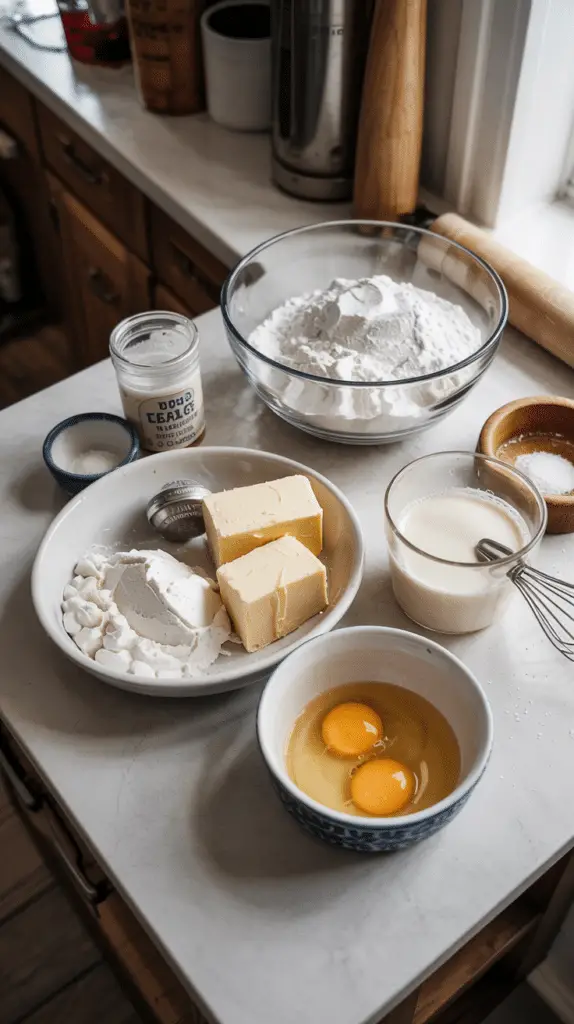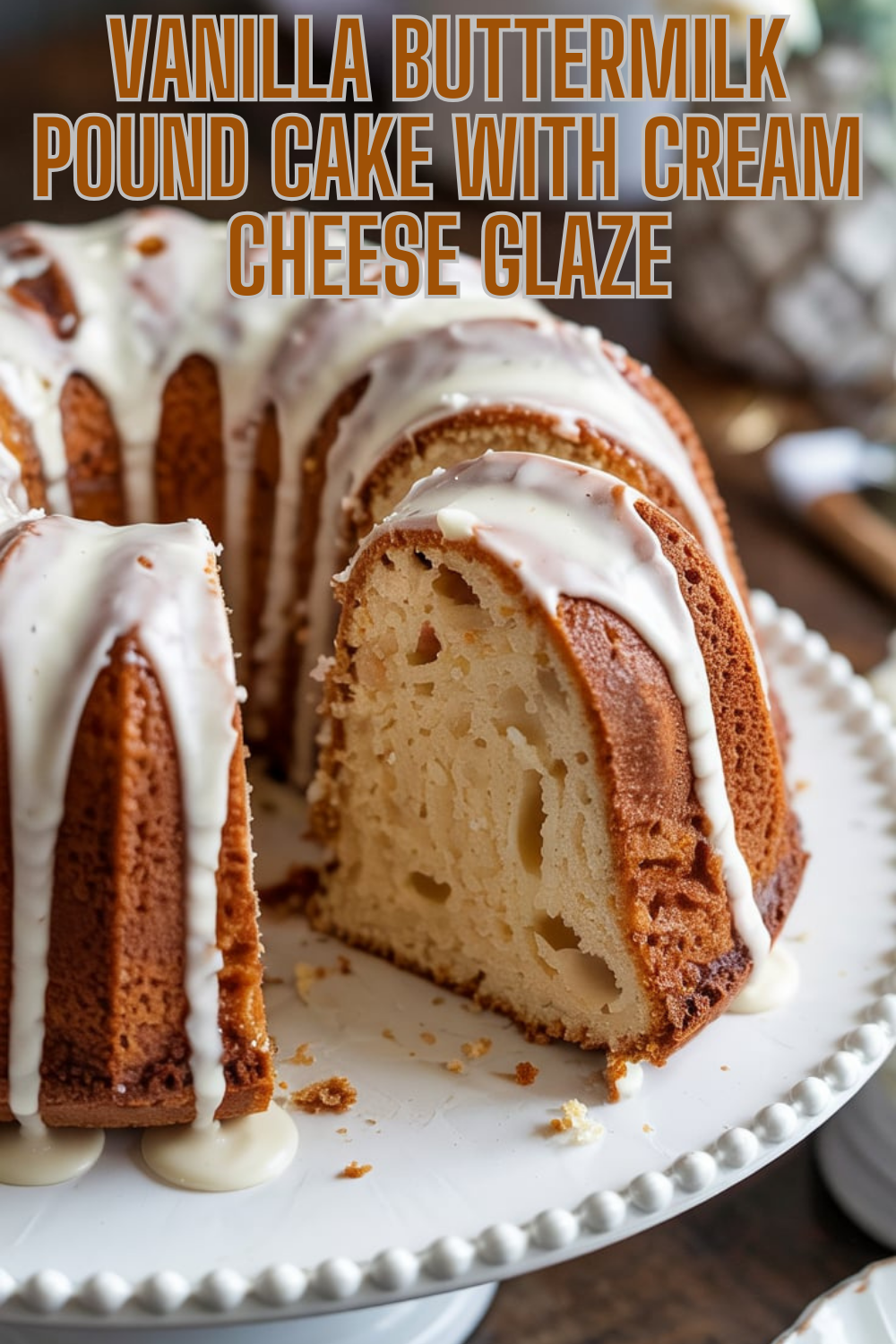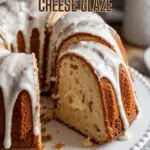Introduction & Inspiration
There’s something incredibly comforting and satisfying about a classic pound cake. Its dense yet tender crumb, rich buttery flavor, and simple elegance make it a timeless dessert. This recipe for Vanilla Buttermilk Pound Cake, finished with a tangy cream cheese glaze, immediately appealed to me as a perfect example of this beloved cake style.
My inspiration came from wanting to bake a reliable, crowd-pleasing cake that feels both special and straightforward. Pound cakes are known for their rich texture, often derived from the traditional “pound of each” ingredient ratio, though modern recipes vary. The addition of buttermilk promised extra moisture and a subtle tang to balance the sweetness.
My goal was to explore this specific recipe, understanding how the buttermilk affects the classic pound cake structure and how the simple cream cheese glaze complements the rich vanilla flavor. It seemed like the perfect recipe for afternoon tea, a potluck, or just a comforting slice with coffee.
Let’s bake this moist, buttery, and simply delicious pound cake!
Nostalgic Appeal
Pound cake holds a significant place in baking history and carries a strong sense of nostalgia. Its name comes from the traditional recipe using a pound each of butter, sugar, eggs, and flour, resulting in a dense, rich cake. It evokes memories of family gatherings, church socials, and classic Southern baking traditions.
The simple, unadorned beauty of a pound cake, often baked in a Bundt or loaf pan, is part of its charm. It doesn’t rely on elaborate decorations, letting its rich flavor and satisfying texture speak for themselves. This recipe, with its optional but lovely cream cheese glaze, maintains that classic appeal.
The use of buttermilk is also a nod to traditional baking, known for adding moisture and a subtle tang that enhances the overall flavor profile and tenderizes the crumb.
Making a pound cake from scratch feels like connecting with a long tradition of home baking, creating something substantial, comforting, and meant for sharing.
Homemade Focus
This Vanilla Buttermilk Pound Cake recipe is a wonderful example of traditional homemade baking techniques yielding exceptional results. While the ingredient list is simple, the method – particularly the creaming of butter and sugar and the alternating addition of wet and dry ingredients – is key to achieving the perfect pound cake texture.
I appreciate recipes that rely on fundamental baking principles. Creaming the butter and sugar properly incorporates air, contributing to the cake’s structure and tenderness. Adding eggs one at a time ensures they emulsify correctly into the batter. Alternating the dry ingredients with the buttermilk prevents overmixing and helps create a smooth, consistent batter.
Making the simple cream cheese glaze from scratch adds another layer of homemade goodness. It provides a tangy counterpoint to the rich cake and allows you to control the sweetness and consistency.
From preparing the pan meticulously to carefully mixing the batter and baking it slowly, every step contributes to a final product that embodies the quality and satisfaction of homemade baking.
Flavor Goal
The primary flavor goal of this Vanilla Buttermilk Pound Cake is a rich, buttery, and distinct vanilla flavor with a moist, dense, yet tender crumb. The buttermilk adds a subtle tanginess that balances the sweetness, and the cream cheese glaze provides a sweet and tangy finish.
The pound cake itself, relying heavily on butter, sugar, and eggs, delivers that classic rich, buttery flavor profile. The vanilla extract provides the warm, aromatic vanilla notes.
The buttermilk contributes moisture and a subtle tang, preventing the cake from being overly sweet and enhancing the overall flavor complexity.
The cream cheese glaze adds a smooth, tangy sweetness that perfectly complements the buttery vanilla cake, cutting through the richness without being overwhelming.
The overall effect is a comforting, deeply satisfying cake with a perfect balance of richness, sweetness, and tang, showcasing the simple elegance of vanilla and butter.
Ingredient Insights
Let’s explore the role of each ingredient in this classic cake:
For the Cake:
- All-purpose flour: Provides the main structure.
- Baking soda: Works with the acidic buttermilk for leavening.
- Salt: Balances sweetness and enhances flavor.
- Unsalted butter, softened: Crucial for flavor, richness, and achieving a tender crumb through proper creaming. Room temperature is essential.
- Granulated sugar: Provides sweetness and aids in the creaming process for texture.
- Large eggs: Add structure, richness, binding, and some leavening. Room temperature helps them incorporate smoothly.
- Vanilla extract: Provides the signature warm flavor.
- Buttermilk: Adds moisture, tanginess, and activates the baking soda for a tender crumb. Room temperature ensures even mixing.
For the Cream Cheese Glaze:
- Cream cheese, softened: Provides the tangy flavor and creamy base.
- Powdered sugar: Sweetens and thickens the glaze. Sifting helps prevent lumps.
- Milk: Adjusts the glaze consistency to make it pourable.
- Vanilla extract: Adds flavor to the glaze.
Using good quality butter and vanilla, and ensuring ingredients are at the correct temperature, are key for pound cake success.
Essential Equipment
You’ll need standard baking tools for this recipe:
- A 10-cup Bundt pan or a large loaf pan (e.g., 9×5 inch): The pan shape influences baking time and appearance. A Bundt pan is classic for pound cake.
- Butter and flour (or baking spray with flour): For thoroughly greasing and flouring the pan to prevent sticking. This is crucial for intricate Bundt pans.
- Medium bowl: For whisking dry ingredients.
- Large mixing bowl: For the cake batter.
- Electric mixer (stand mixer or handheld): Highly recommended for properly creaming the butter and sugar and beating the frosting.
- Whisk:
- Rubber spatula:
- Wire rack: Essential for cooling the cake properly.
- Medium bowl: For the glaze.
- Measuring cups and spoons.
Thorough pan preparation is vital for Bundt cakes.
List of Ingredients with Measurements
Here’s the complete list of ingredients, with precise measurements:
For the Cake:
- 3 cups (375 g) all-purpose flour
- 1/2 teaspoon baking soda
- 1/4 teaspoon salt
- 1 cup (225 g / 2 sticks) unsalted butter, softened
- 2 1/2 cups (500 g) granulated sugar
- 4 large eggs, room temperature
- 1 tablespoon vanilla extract
- 1 cup (240 ml) buttermilk, room temperature
For the Cream Cheese Glaze:
- 4 oz (115 g) cream cheese, softened
- 1 cup (120 g) powdered sugar, sifted
- 2–3 tablespoons milk (adjust for desired consistency)
- 1/2 teaspoon vanilla extract
These quantities create a substantial pound cake.
Ensure butter, eggs, and buttermilk are at room temperature before starting.

Step-by-Step Instructions
Let’s bake this delicious pound cake:
1. Prepare Oven and Pan: Preheat your oven to 325°F (160°C). Thoroughly grease and flour a 10-cup bundt pan or a large loaf pan. Set aside.
2. Mix Dry Ingredients: In a medium bowl, whisk together the flour, baking soda, and salt. Set aside.
3. Cream Butter and Sugar: In a large mixing bowl (or stand mixer bowl), beat the softened butter and granulated sugar together on medium-high speed until very light and fluffy, about 3-4 minutes. Proper creaming is key for texture.
4. Add Eggs and Vanilla: Beat in the room temperature eggs one at a time, ensuring each is fully incorporated before adding the next. Scrape down the bowl. Stir in the vanilla extract.
5. Combine Wet and Dry Ingredients (Alternating): Add the dry ingredients to the butter mixture in three additions, alternating with the buttermilk (beginning and ending with the dry ingredients). Mix on low speed just until combined after each addition. Do not overmix.
6. Bake the Cake: Pour the batter into the prepared pan and smooth the top. Bake for 60-70 minutes, or until a long wooden skewer or toothpick inserted into the center comes out clean. Pound cakes require a longer baking time at a lower temperature.
7. Cool the Cake: Let the cake cool in the pan on a wire rack for 10 minutes. Then, carefully invert it out onto the wire rack to cool completely.
8. Make the Cream Cheese Glaze: While the cake cools (or once cooled), make the glaze. In a medium bowl, beat the softened cream cheese until smooth. Gradually add the sifted powdered sugar and 2 tablespoons of milk, mixing until the glaze is smooth and pourable. Add more milk, 1 teaspoon at a time, to reach your desired drizzling consistency. Stir in the vanilla extract.
9. Glaze the Cake: Once the cake is completely cooled, drizzle the cream cheese glaze over the top, allowing it to drip down the sides.
10. Serve: Slice and enjoy!
Patience during baking and cooling is important!

Troubleshooting
Pound cakes can sometimes be tricky. Here are potential issues:
- Problem: Cake is dry.
- Solution: Usually caused by overbaking or inaccurate flour measurement. Use an oven thermometer to check temperature accuracy. Start checking for doneness at the minimum time. Spoon and level flour, or weigh it.
- Problem: Cake is dense or tough.
- Solution: Overmixing after adding the flour is a common culprit. Mix just until combined. Ensure proper creaming of butter and sugar. Make sure leavening (baking soda) is fresh.
- Problem: Cake sunk in the middle.
- Solution: Oven temperature might be inaccurate (too high or too low). The cake might be underbaked. Avoid opening the oven door too early. Ensure leavening is fresh.
- Problem: Cake stuck to the pan (especially Bundt).
- Solution: Thorough greasing and flouring of every nook and cranny of the pan is essential. Use shortening for greasing for best results. Let the cake cool in the pan for the specified 10 minutes before inverting.
- Problem: Glaze is too thick/thin.
- Solution: Adjust consistency by adding more milk (to thin) or more sifted powdered sugar (to thicken).
Proper technique prevents most pound cake problems.
Tips and Variations
Let’s customize this classic:
- Tip: Ensure butter, eggs, and buttermilk are all at room temperature for the best batter emulsion and cake texture.
- Variation: Add the zest of 1-2 lemons or oranges to the batter along with the vanilla for a citrusy pound cake.
- Tip: Use high-quality vanilla extract or vanilla bean paste for the best flavor.
- Variation: Fold in 1 cup of berries (like blueberries, tossed in flour), chopped nuts (pecans, walnuts), or mini chocolate chips into the batter before baking.
- Tip: If using a dark Bundt pan, you might need to slightly reduce the oven temperature or baking time.
- Variation: Skip the cream cheese glaze and opt for a simple powdered sugar dusting, a lemon glaze, or serve with fresh fruit and whipped cream.
A perfect base for many flavors!
Serving and Pairing Suggestions
Vanilla Buttermilk Pound Cake is wonderfully versatile.
Serving: Serve slices at room temperature.
Pairing:
- Perfect on its own with coffee or tea for breakfast or an afternoon snack.
- Delicious served with fresh berries (strawberries, raspberries, blueberries) and a dollop of whipped cream.
- Excellent lightly toasted with butter.
- A scoop of vanilla bean or fruit ice cream makes it a more decadent dessert.
- Great for potlucks, bake sales, or as a simple, elegant dessert after dinner.
It’s a comforting classic that suits almost any occasion.
Nutritional Information
Pound cake is traditionally rich in butter, sugar, and eggs. Nutritional information is approximate and depends on slice size (assuming 12-16 slices from a 10-cup Bundt):
- Calories: 350-450+
- Fat: 18-28+ grams
- Saturated Fat: 10-18+ grams
- Cholesterol: 80-120+ mg
- Sodium: 150-250+ mg
- Total Carbs.: 45-60+ grams
- Dietary Fiber: <1-2 grams
- Sugars: 30-45+ grams
- Protein: 4-6 grams
This is a rich, dense cake, best enjoyed in moderation.
PrintVanilla Buttermilk Pound Cake with Cream Cheese Glaze
Bake a classic, moist Vanilla Buttermilk Pound Cake with this easy recipe! Features a tender crumb and a tangy cream cheese glaze. Perfect for any occasion
Ingredients
Here’s the complete list of ingredients, with precise measurements:
For the Cake:
- 3 cups (375 g) all-purpose flour
- 1/2 teaspoon baking soda
- 1/4 teaspoon salt
- 1 cup (225 g / 2 sticks) unsalted butter, softened
- 2 1/2 cups (500 g) granulated sugar
- 4 large eggs, room temperature
- 1 tablespoon vanilla extract
- 1 cup (240 ml) buttermilk, room temperature
For the Cream Cheese Glaze:
- 4 oz (115 g) cream cheese, softened
- 1 cup (120 g) powdered sugar, sifted
- 2–3 tablespoons milk (adjust for desired consistency)
- 1/2 teaspoon vanilla extract
These quantities create a substantial pound cake.
Ensure butter, eggs, and buttermilk are at room temperature before starting.
Instructions
Let’s bake this delicious pound cake:
1. Prepare Oven and Pan: Preheat your oven to 325°F (160°C). Thoroughly grease and flour a 10-cup bundt pan or a large loaf pan. Set aside.
2. Mix Dry Ingredients: In a medium bowl, whisk together the flour, baking soda, and salt. Set aside.
3. Cream Butter and Sugar: In a large mixing bowl (or stand mixer bowl), beat the softened butter and granulated sugar together on medium-high speed until very light and fluffy, about 3-4 minutes. Proper creaming is key for texture.
4. Add Eggs and Vanilla: Beat in the room temperature eggs one at a time, ensuring each is fully incorporated before adding the next. Scrape down the bowl. Stir in the vanilla extract.
5. Combine Wet and Dry Ingredients (Alternating): Add the dry ingredients to the butter mixture in three additions, alternating with the buttermilk (beginning and ending with the dry ingredients). Mix on low speed just until combined after each addition. Do not overmix.
6. Bake the Cake: Pour the batter into the prepared pan and smooth the top. Bake for 60-70 minutes, or until a long wooden skewer or toothpick inserted into the center comes out clean. Pound cakes require a longer baking time at a lower temperature.
7. Cool the Cake: Let the cake cool in the pan on a wire rack for 10 minutes. Then, carefully invert it out onto the wire rack to cool completely.
8. Make the Cream Cheese Glaze: While the cake cools (or once cooled), make the glaze. In a medium bowl, beat the softened cream cheese until smooth. Gradually add the sifted powdered sugar and 2 tablespoons of milk, mixing until the glaze is smooth and pourable. Add more milk, 1 teaspoon at a time, to reach your desired drizzling consistency. Stir in the vanilla extract.
9. Glaze the Cake: Once the cake is completely cooled, drizzle the cream cheese glaze over the top, allowing it to drip down the sides.
10. Serve: Slice and enjoy!
Patience during baking and cooling is important
Recipe Summary and Q&A
Let’s conclude with a summary and common questions:
Recipe Summary:
Vanilla Buttermilk Pound Cake is a classic, moist, and tender cake made using the creaming method with butter, sugar, eggs, flour, buttermilk, and vanilla. It features a dense yet fine crumb characteristic of pound cakes, enhanced by the moisture and tang of buttermilk. It’s finished with a simple, tangy cream cheese glaze.
Q&A:
Q: Can I make this cake ahead of time? A: Yes. Pound cakes often taste even better the next day! Bake the cake and store it well-wrapped at room temperature for 2-3 days, or in the refrigerator for up to a week. Glaze closer to serving time or just before.
Q: How should I store the cake? A: Store unfrosted cake well-wrapped at room temperature for several days. Once glazed (due to the cream cheese), store covered in the refrigerator for up to 5 days. Let come to room temperature before serving for best texture.
Q: Can I freeze this cake? A: Yes. Freeze the unglazed, completely cooled cake wrapped tightly in plastic wrap and then foil for up to 3 months. Thaw overnight at room temperature or in the refrigerator before glazing.
Q: I don’t have buttermilk. What can I substitute? A: Make a substitute: Place 1 tablespoon of white vinegar or lemon juice in a liquid measuring cup, then add milk (any kind, preferably whole or 2%) to reach the 1 cup line. Stir and let sit for 5-10 minutes before using.
Q: Can I use a loaf pan instead of a Bundt pan? A: Yes, a large loaf pan (like 9×5 inches) will work, but the baking time might differ slightly (check with a skewer). Ensure the pan is deep enough to hold the batter.
I hope this comprehensive guide helps you bake a perfect Vanilla Buttermilk Pound Cake! It’s a timeless classic for a reason. Enjoy!
Did Our Recipe Hit The Spot?
There are no reviews yet. Be the first one to write one.


